back to
1912-1921 2¢ Washington Types I-III
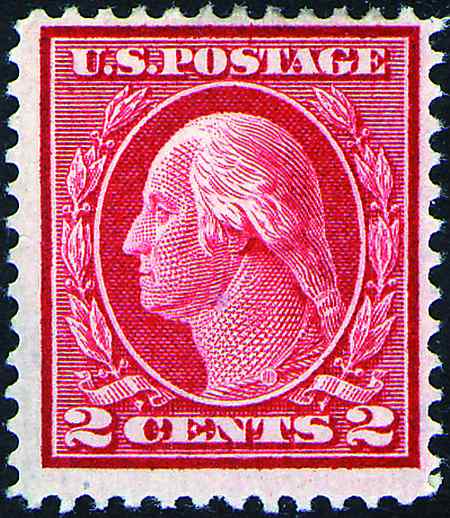
In identifying the types of the 2 cent Washington, bear in mind that some of the identifying characteristics belong to more than one type, while others belong to one type. To positively identify a specific type, you must be certain that all of the characteristics are present, although this can be difficult with used stamps when a cancel may obscure some identifying characteristics.
1: The number of lines in the left ribbon
 |
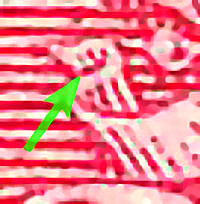 |
|
|
Types I, Ia, II: There is only 1 vertical shading line at the end of the left ribbon over the “2”. |
Type III: There are 2 vertical shading lines at the end of the ribbon. |
2: The number of lines in the right ribbon
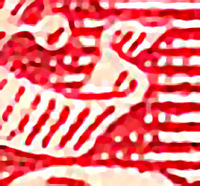 |
 |
|
|
Types I, Ia, II: There is only 1 vertical shading line in the last fold of the right ribbon over the “2”. |
Type III: There are 2 vertical shading lines in the last fold of the right ribbon. This is the most visible distinguishing feature of Type III. |
Note: Sometimes one of the shading lines in each ribbon is scraped off to produce a fake Type II stamp. However, there are other features to identify a genuine Type II stamp.
3: The toga rope and toga button
 |
|
|
|
Type I: The top line of the toga button and the top line of the front of the toga are thin and weak. The top of the slanted vertical hatch lines of the toga's front edge are thin at the top and thicker at the bottom. This is a unique feature of Type I. |
Types Ia, II, III: The top line of the toga button and and the top line of the front of the toga are well defined and sharp. The slanted vertical hatch lines of the toga's top front edge are clear and uniform in their entirety. This is a major characteristic that defines Type Ia from Type I. |
4: The line in the middle of the right ribbon
 |
 |
|
|
Types I, Ia: The first shading line after the first ribbon fold of the right ribbon often appears as a single, unbroken line. Sometimes it may have one or two breaks. The bottom third of this line often appears stronger. |
Types II, III: The first shading line after the first ribbon fold of the right ribbon usually appears as a series of 3 dashes. |
5: The line between the cheek and the sideburn
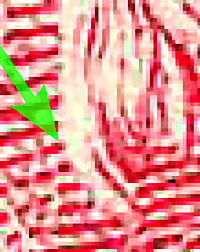 |
 |
|
|
Type I: The horizontal shading lines to the immediate left of the sideburn are not joined. Some Type I stamps may have 2 or 3 lines joined, but will never have all 5 lines joined as in Type II. |
Type Ia: The horizontal shading lines to the immediate left of the sideburn are lightly joined. In this example, the bottom 3 lines are lightly joined, but it will never have 5 lines strongly joined as in Type II. |
|
 |
 |
|
|
Type II: At least 4, and often 5, of the horizontal shading lines to the immediate left of the sideburn are joined by a distinct vertical line. This is an important distinguishing feature of Type II. |
Type III: A distinct vertical line joins at least 5 of the horizontal shading lines to the immediate left of the sideburn. This is an important and unique distinguishing feature of Type III. |
6: The line under the ear
 |
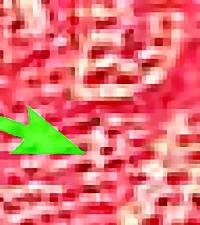 |
|
|
Type I: Directly below the ear there are several shading lines which are clearly severed, resulting in the appearance of a thin white vertical line. |
Type Ia: The white line under the ear is less pronounced than Type I but more pronounced than Type II. |
|
 |
 |
|
|
Type II: The white line under the ear is not as pronounced as Type I or Ia but is still slightly visible. |
Type III: The white line under the ear is barely visible. The horizontal shading lines under the ear are nearly intact. |
7: The shape of the mouth
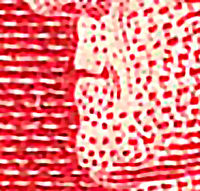 |
 |
|
|
Types I, Ia, II: The dark line forming the mouth is straight across the bottom, and may curve upward slightly in the corner. |
Type III: The dark line forming the bottom of the mouth is crooked across the bottom, particularly at the end where it dips down. This is a unique feature of Type III, and it may be more pronounced in some examples. |
8: The lines of shading in the locks of hair
 |
 |
|
|
Type I: The two lines of shading in the lock of hair directly to the right of the ear are of different lengths, the bottom one being much shorter. |
Type Ia: The two lines of shading in the lock of hair directly to the right of the ear are of different lengths, the bottom one being much shorter. |
|
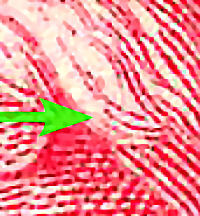 |
 |
|
|
Type II: The two lines of shading in the lock of hair directly to the right of the ear are of approximately the same length. They extend to the vertical lock of hair just to the right. |
Type III: The two lines of shading in the lock of hair directly to the right of the ear are of unequal length, the bottom one being longer than the top. They extend beyond the vertical lock of hair just to the right. |
9: The shape of the top right laurel berry
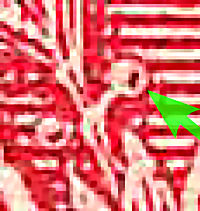 |
 |
|
|
Type I: The top right laurel berry has only a single shading dot, usually appearing as an indistinct blob. On heavily inked examples this dot appears quite large. |
Type Ia: The top right laurel berry is an indistinct blob with a slight “v” shape, but not as distinct as Type III. |
|
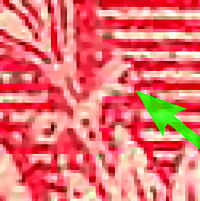 |
 |
|
|
Type II: The top right laurel berry has only a single shading dot, usually appearing as an indistinct blob. On heavily inked examples this dot appears quite large. |
Type III: The top right laurel berry has three shading dots which often run together to form a “v”. This feature is not always distinct. |
To summarize the four types:
Type I: Weak lines, one line in ribbon, flat plate and rotary.
Type Ia: Same as Type I but stronger lines, flat plate only. It is generally a clearer and heavier print than Type I.
Type II: Same as Type Ia but strong shading lines on sideburn, rotary only. It is generally much sharper and printed in a heavier ink than Types I and III.
Type III: Same as Type II, ribbon has 2 lines and top laurel berry has 3 dots in a “V” shape, rotary only.


